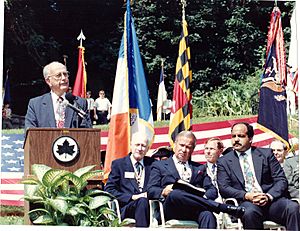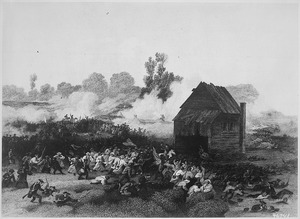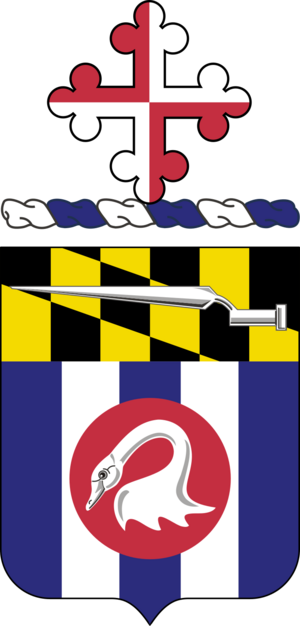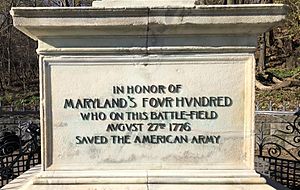Maryland 400 facts for kids
The Maryland 400 were a brave group of soldiers from the 1st Maryland Regiment. They are famous for their actions during the Battle of Long Island in the Revolutionary War. Even though they were greatly outnumbered, they charged the British army many times. This heroic stand allowed General Washington to move most of his troops safely to Manhattan. This important event is why Maryland is sometimes called the "Old Line State." There is a monument in Brooklyn and several plaques that remember these soldiers.
Contents
Forming the Regiment and Their Fight
The soldiers who became the Maryland 400 were part of the earliest groups of fighters in Maryland. These groups were formed to protect the western frontier. The unit's official start date, June 14, 1775, is also the birthday of the United States Army.
The first two companies from Maryland were rifle companies. They gathered in Frederick, Maryland, in the summer of 1775. They marched about 551 kilometers (342 miles) in 21 days to join General Washington. They helped Washington try to push the British out of Boston. Later, more Maryland fighters joined. They were armed with older British muskets and bayonets. They were sent north to help Washington in New York City.
At the Battle of Long Island, the 1st Maryland Regiment was led by Colonel William Smallwood. This unit held the far right side of the American lines. They faced a surprise attack from British General Grant.
The Marylanders' Brave Stand
Lord Stirling was an American general. He ordered most of his troops to cross a creek to safety. But he left a group of Maryland soldiers behind. This group was led by Major Mordecai Gist. These Maryland troops became known as the Maryland 400. There were actually about 260 to 270 men in this group.
Stirling and Gist led these soldiers in a "rear-guard action." This means they fought to protect the main army as it retreated. They faced more than 2,000 British soldiers, who also had two cannons. The Marylanders charged the British twice. The British were in strong positions near the Vechte-Cortelyou House.
After their last attack, the remaining Marylanders tried to retreat across the Gowanus Creek. Some got stuck in the mud while being shot at. Others who couldn't swim were captured. Lord Stirling was surrounded. He didn't want to surrender to the British. So, he broke through their lines and surrendered to the Hessians. Hessians were German soldiers fighting for the British.
More than 100 Marylanders were captured. A total of 256 were killed. This nearly wiped out the regiment in front of the Old Stone House. Fewer than a dozen soldiers made it back to the American lines. General Washington watched from a nearby fort. He was said to have cried, "Good God, what brave fellows I must this day lose!"
Where the Soldiers Were Buried
The 256 Maryland soldiers who died were buried by the British. They were placed in a large mass grave on a small hill. This hill was on farmer Adrian Van Brunt's land, near a marsh. People believe this mass grave is now around the southwest corner of 3rd Avenue, between 7th and 9th Streets in Brooklyn. The bodies were buried in six trenches, facing east.
Finding the Burial Site
In the 1890s, the entire area was covered with 12 feet of dirt. Buildings were put up over the site. It became a coal yard and then a paint factory. In 1956, a doctor named Nicholas Ryan said his father, a builder, found "the bones of some thirty bodies in regular, or military order" in the 1890s. This was when he was digging cellars for apartment buildings at 7th Street and 3rd Avenue.
In 1957, the U.S. National Park Service looked into the site. They found a plaque that marked what people thought was a mass grave. But when students from Columbia University did a small archeological dig, they didn't find any remains. At that time, it was decided not to protect the site.
In 1998, the Archaeological Research Center at Brooklyn College was asked to check if the Marylanders might be buried under the southwest corner of 7th Street and 3rd Avenue. Again, nothing was found. In 2008, another archaeologist, Dr. Joan E. Geismar, visited the area. She didn't find remains, but she did find a buried stone marker.
Today, many believe the actual burial site is under a parking lot for an auto repair shop. This is in Park Slope, Brooklyn. A group of historians wants to buy the property. They hope to search the site again for the graves.
History of the Regiment
The Maryland 400 were considered the best of the Maryland Line. The Maryland Line was a group of regiments known for being among the best in the Continental Army. Because these regiments served for a long time and were very good, George Washington supposedly called them his "Old Line." This is how Maryland got one of its nicknames, "The Old Line State."
The U.S. 115th Infantry Regiment was a Maryland Army National Guard regiment. It traced its history back to the American Revolutionary War, including the Maryland 400. The units connected to the 115th Regiment fought in the Revolutionary War and the Civil War. The 115th Regiment itself fought in World War I, World War II, and the Global War on Terror. In 2006, the 115th was combined with the 175th Infantry Regiment. Because of this, it no longer exists as a separate regiment.
The bayonet on the symbol of the 175th Infantry Regiment is important. It shows that American soldiers first used bayonets effectively at the Battle of Long Island. This was done by the Maryland Line in 1776. The bayonet also stands for the Maryland 400.
Memorials Honoring the Maryland 400

Maryland 400 Monument in Prospect Park
The Maryland Monument is in Prospect Park, in Brooklyn, New York City. It stands on the side of Lookout Hill. The famous architect Stanford White first imagined it. The monument is a tall stone pillar made of Maryland granite. It has bronze plaques on its four sides. It cost $3,000 to build, which was given by the "Maryland Society of the Sons of the American Revolution."
The monument is 27 feet tall and faces southwest. A strong wrought-iron fence surrounds it. It has a 12-foot polished granite pillar with a marble ball on top. Behind it is a curved stone wall. The Brooklyn Parks Department donated a marble base for the monument.
On the front of the monument's base, there is an inscription. It honors the Maryland 400 soldiers. It reads: "In honor of the Maryland 400 who on this battlefield on August 27, 1776 saved the American army." On the back of the marble base, there is another inscription. It is a quote believed to be from Washington. He said it as he watched the Marylanders fight: "Good God! What brave fellows I must this day lose."
The monument was officially dedicated on August 27, 1895. This was the 119th anniversary of the battle. U.S. troops, patriotic groups, and other military units took part in the ceremony. The unique iron fence around the monument was added later to protect it.
The monument has been damaged and fixed many times. It was first repaired in 1935–36. More work was done in 1969. In 1991, it was repaired again and rededicated. This repair cost $35,000. It involved cleaning, fixing broken parts, replacing missing letters, and fixing the rusted fence. In 2008 and 2009, more restoration work was done. This included replacing missing bronze letters and cleaning the stonework.
Other Plaques and Markers
In 1993, a bronze marker was placed outside the American Legion Post 1636. This is at 193 9th Street in Gowanus, Brooklyn. It is close to where the soldiers fell. It says: "In Honored Memory of Maryland's 400. Forever Remembered."
At some point, a tablet was placed in the sidewalk of 5th Avenue by the Sons of the Revolution. This bronze tablet is about four and a half by five feet. It is now part of a rebuilt house. It reads: "Here on the 27th of August, 1776, Two hundred and fifty out of four hundred brave Maryland soldiers, under the command of Lord STIRLING, were killed in combat with British troops under CORNWALLIS."
There is a New York State Historical sign from 1947. It is above the front door of the American Legion Post 1636 in Brooklyn. It reads: "Maryland Heroes, Here lie buried 256 Maryland Soldiers who fell in the Battle of Brooklyn, Aug. 27, 1776."
In 1897, a plaque was placed very close to the actual grave site. It was in front of the Wildhack Coal Yard. This plaque was covered around 1915 when 3rd Avenue was made wider. It was finally removed in 2008. It read: "Burial place of ye – Maryland Soldiers who – Fell in ye – Combat at ye – Cortelyou House in ye– Battle of Long Island on ye – 27th day of August, 1776."







